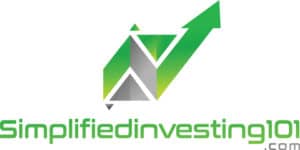
When I first started buying stocks more than 3 years ago, I was quite clueless about how the stock market works. I tried to time the market instead of investing long-term.
When done correctly, stock investing is a great way to build long-term wealth. While considered more risky, returns from stocks (around 10% per year – last 100 years) had historically outperformed compared to other investments.
1. Open a Self-Directed Investing Account
Investing accounts in Canada enables you to buy and sell stocks, ETFs, bonds, and most investment assets. Personally, I use both Wealthsimple Trade and Questrade, mainly because of their low commission fees.
Platforms such as Robinhood, Fidelity, and Webull are available in the United States. In Canada, we have Questrade, TD Direct Investing, Wealthsimple Trade, and most of the big banks.
Canadian stock trades on Wealthsimple Trade are commission free. Also, Questrade’s commission fee for stocks is around $5 per buy or sell trade.
Most big banks also offers self-directed accounts such as the TD Direct Investing and RBC Direct Investing. However, commission fees on the big banks is a bit higher which is typically about $9.95 per buy or sell stock trade.
Wealthsimple Trade
I am using Wealthsimple Trade for more than 3 years now. I traded stocks using Wealthsimple Trade, Questrade, and RBC Direct Investing. Among them, Wealthsimple Trade is the easiest to use. On the other hand, it took me more than a month to get used to RBC DI and Questrade.
- No minimum requirement. Anyone can start with $100 or less.
- $0 commission fees on trades
- Stocks & ETFs listed in stock exchanges in the United States and Canada
- 1.50% exchange rate fee for US dollar trades
- Fractional Trading
- More than 2 Million People have a Wealthsimple account
- Best for Beginners – Platform is simple and easily understandable. (Beginner-friendly user interface)
Visit wealthsimple.com for more details. A $25 bonus may be applied after trading at least $150 of any stocks.
Wealthsimple Trade Tutorial – How to Buy and Sell Stocks (US and CAD stock)
Wealthsimple Video Tutorial: How to Trade Fractional Shares on Wealthsimple Trade
Questrade
Questrade has been operating for more than 20 years in Canada. Questrade is one of the top investing platforms in Canada. I am trading with Questrade for more than 2 years now.
- Minimum of $1,000 to open an account
- $4.95 commission fees for every stock trade (buy or sell)
- 2% US dollar exchange rate fee
- Questrade is operating for more than 20 years. More than 200,000 new accounts every year
Questrade – How to Buy and Sell Stocks
The tutorial video is done on a Questrade Margin account. The process of how to buy and sell stocks in a Questrade TFSA is the same.
2. Types of Investing Accounts in Canada (For Tax Purposes)
Normally, investment gains are taxable. Investment profits from stocks on a regular personal/cash or margin accounts are taxable. On the other hand, stocks on a registered account such as TFSA and RRSP offers tax advantages.
However, TFSA and RRSP have rules to follow while regular accounts (Personal/Cash and Margin) have little to no rules.
TFSA and Margin or Personal accounts offers more flexibility. For example, deposits and withdrawals to personal and margin accounts have no limit. Also, you can trade as often as you like on personal and margin accounts.
TFSA or a Personal (Cash) account is best to use for the first time in investing in stocks. RRSP is designed for retirement. RRSP have quite a bit more complicated tax rules. Mismanaging RRSP can negatively affect your retirement savings.
TFSA, RRSP, and Personal/Margin accounts are available on Questrade, Wealthsimple Trade, and the big banks.
Personal and Margin Accounts (Non-Registered)
- Day trading is allowed.
- Profits are taxable. Income needs to be declared when filing tax returns during tax season.
- No limit on the amount of deposits, withdrawals, and number of trades.
- Non-registered accounts are also called Personal, Cash, or Margin accounts. These are essentially the same account for tax purposes.
RRSP
- Designed for retirement
- Contributions (deposits) to RRSP are tax deductible up to your contribution limit
- Withdrawals are taxable income. Tax brackets are usually lower on retirement
TFSA
- Investment income from stocks (and other assets) inside a TFSA is tax-free
- Deposits to TFSA are limited up to your TFSA limit. The TFSA limit for 2022 is $6,000. If you are investing more than $6,000, you may want to consider a non-registered account or check your TFSA limit on your CRA account in case you have unused TFSA limit from past years,
- Day trading as a business is not allowed on TFSA.
- You can deposit and withdraw cash anytime from a TFSA.
3. Consider starting with Small Capital for the First Few Months
A small capital of $500 or less may be optimal when investing for the first time. Stocks can be risky. With small amounts of capital, you can lose less money.
Once you become more comfortable investing in stocks, you can consider investing more capital. At the same time, you may gain experience and know what it feels like to actually own stocks.
4. Consider Diversified Stock Index ETFs
Individual stocks can be risky. Stocks such as Tesla and Shopify have crashed more than 50% in value several times. Also, the worst-case scenario is when a company goes bankrupt, which will make the stock price become $0.
ETFs (Exchange Traded Funds) are often used to invest in a stock index like the S&P 500. The S&P 500 tracks the 500 largest stocks listed on the United States stock exchanges. The returns of the S&P 500 reflect the performance of the 500 stocks.
Diversification through ETFs like the S&P 500 is helpful to minimize risks. In case one of the 500 stocks in the index go bankrupt, this will have a small impact on the investment as there are a total of 500 stocks in the index.
S&P 500 is the most common tracker of how the stock market is performing in a day, several months, or years.
The largest stocks in the S&P 500 includes Amazon, Microsoft, Apple, Netflix, Tesla, and Google (Alphabet) stock. S&P 500 is similar to investing small portions in each of the 500 stocks of the index.
S&P 500 ETFs
- SPY (USD)
- VOO (USD)
- IVV (USD)
- VSP (CAD)
- XSP (CAD)
- VFV (CAD)
- XUS (CAD)
Instead of buying every single stock of the S&P 500, investing in VOO (S&P 500 ETF) will give you returns close to the S&P 500. Should the S&P 500 rise by 10%, these ETFs will also rise by close to 10%. At the same time, these ETFs will also drop close to 10% in case the S&P 500 ETF drop by 10%.
SPY, VOO, and IVV are a few S&P 500 ETFs listed in US dollars (USD) while VSP, XSP, VFV, and XUS are S&P 500 ETFs that can be traded in Canadian dollars (CAD).
S&P 500 Historical Returns
S&P 500 has returned around 10.31% per year on average in the last 100 years.
Number of Years (89 Years) and Returns of the S&P 500

Source: LPL Financial
Key Takeaways:
- Only 6.7% of years have returns of exactly between 5 to 10 percent
- Two-thirds (66.3%) of the years generated positive returns (above 0% returns).
- One-third (33.7%) of the years generated negative returns (below 0% returns).
- Half (50.6% – 45 out of 89 years) of the years returned more than 10%.
- Half (49.4% – 44 out of 89 years) of the years returned less than 10%.
The chart shows that the yearly returns of the S&P 500 stock market are spread out. While the average is about 10% per year, just about a fifth (20%) of the time the market returns between 5% to 15% on a year. Most of the time (80% of the years), the market returned below 5% or above 15%.
The two extremes (less than 10% and greater than 20% returns) happened on a combined (close to half the time) 48.3% of the years. On a 10-year period, you can expect that 5 of those years will return either greater than 20% or less than 10%.
Thus, the stock market is best for long-term investing since short-term returns are unpredictable.
5. Gain Experience and Constantly Save and Invest
Everyone makes mistakes, not only in investing but in life in general. After all, every expert was once a beginner. Mistakes are okay as long as we learn from them.
Investing regularly is a solid method to build long-term wealth. Plan ahead how much you are willing to set aside monthly and what plan where to invest. A mix of different investments is also possible.
Compound Interest – Advantage of Long Term Investing
Stocks vs Savings Account (Compound Interest – $500 Every Month)
| Stocks (Assume 10% returns per year) | Savings account (Assume 2% returns per year) | No investment (Cash – 0% returns) | |
| 1 Year | $6,335 | $6,065 | $6,000 |
| 5 Years | $39,041 | $31,576 | $30,000 |
| 10 Years | $103,276 | $66,470 | $60,000 |
| 20 Years | $382,848 | $147,644 | $120,000 |
| 30 Years | $1,139,663 | $246,773 | $180,000 |
Assumptions: 10% per year vs 2% per year. Actual returns will be different.
Compound interest is noticeable in the long term. The difference is hardly noticed in the table for 1 year and 5 years. The difference in returns is huge on the 20 to 30 year horizon.
Compound interest is where interest earns interest. For example, $100 at 10% per year will result to $10 in interest income. At year 2, the $10 interest from year 1 will also earn 10%, so the total interest on year 2 will be $11 vs $10 on year 1. Compound interest is a big factor in the long term (more than 10 years down the road).
“The best time to plant a tree was 20 years ago. The second best time is now.”
– Chinese proverb
